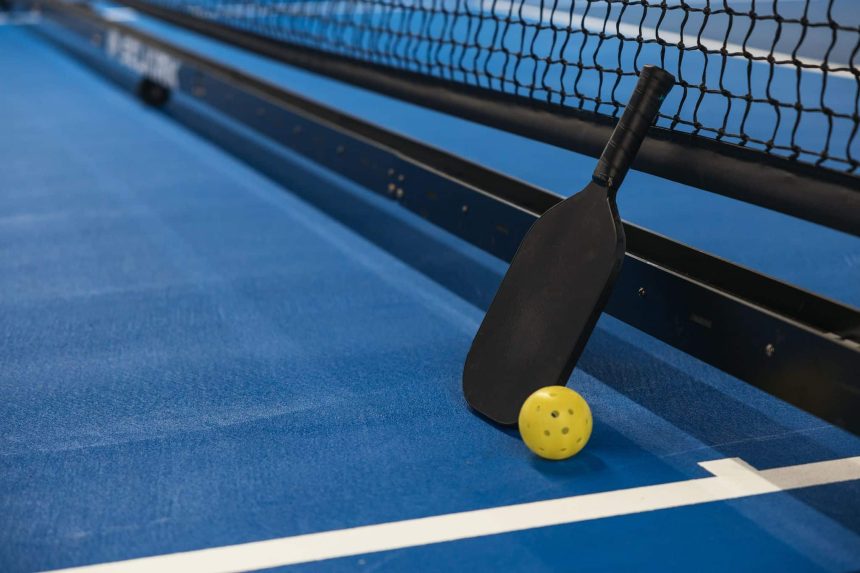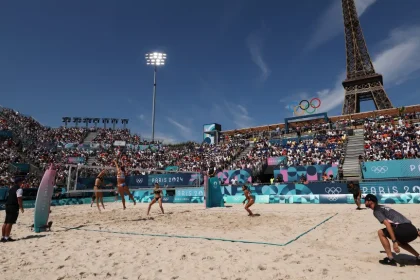Pickleball is a paddle sport that combines elements of tennis, badminton, and table tennis. It is played on a court measuring 20×44 feet (about a third the size of a tennis court) with a net lowered to 34 inches at the center. Players use solid paddles (larger than table tennis paddles, typically made of composite or wood) to hit a perforated plastic ball, similar to a wiffle ball, over the net. The game can be played as singles or doubles, with doubles being more common due to its social nature. The objective is to score points by landing the ball in the opponent’s court without it being returned, with games typically played to 11 points (win by 2).
Key rules include:
- The serve must be underhand, below the waist, and diagonal across the court.
- The ball must bounce once on each side before volleys (hitting the ball in the air) are allowed, known as the “double-bounce rule.”
- A 7×20-foot non-volley zone near the net (the “kitchen”) prevents players from smashing the ball at close range, encouraging strategic play.
Invented in 1965 on Bainbridge Island, Washington, by Joel Pritchard, Bill Bell, and Barney McCallum, pickleball was designed as a family-friendly activity. Its name likely derives from Pritchard’s dog, Pickles, who chased the ball, or a rowing term, “pickle boat,” for a mixed crew. The sport has grown from a backyard game to a global phenomenon, with over 48 million players in the U.S. alone in 2023 and a presence in 70+ countries.
Why is Pickleball So Popular in the Global Sports Market?
Pickleball’s rapid rise in popularity can be attributed to several factors:
- Accessibility: The sport is easy to learn, with simple rules and a small court size that doesn’t demand high athleticism. It’s playable on converted tennis or badminton courts, in gyms, or even driveways, requiring minimal space.
- Inclusivity: Pickleball appeals to all ages and skill levels, from children to seniors. The average player age has dropped to 34.8, but 33% of core players are over 65, drawn to its low-impact exercise. It’s also affordable, with basic paddles costing $20-$50.
- Health Benefits: It provides cardiovascular exercise, improves balance, and enhances coordination. Studies, like the Apple Heart and Movement Study, show players reach peak heart rates of 143 bpm, offering fitness benefits without excessive strain.
- Social Appeal: The doubles format fosters camaraderie, and the sport’s relaxed vibe encourages community-building. Venues like Chicken N Pickle help promote the sport to combine courts with dining and entertainment, enhancing the social experience.
- Market Growth: The global pickleball market, valued at $2.2 billion in 2024, is projected to reach $9.1 billion by 2034 (15.3% CAGR). Growth is driven by equipment sales, court construction, and tourism from tournaments. The U.S. has over 70,641 courts, with demand spurring investment.
- Media and Celebrity Boost: Coverage on ESPN, CBS, and Tennis Channel, plus investments from celebrities like LeBron James and Ellen DeGeneres, have raised its profile. Social media, especially TikTok, amplifies its appeal among younger players.
- Competitive Opportunities: Professional tours (PPA, APP, MLP) and major events like the USA Pickleball National Championships draw players and spectators, with millions in prize money. The sport’s potential Olympic inclusion by 2028 adds prestige.
- Global Spread: Beyond the U.S., countries like Canada (1.37 million players), Australia (9,000 members), and India show strong growth, supported by the International Federation of Pickleball’s 63 member nations.
Getting into pickleball is straightforward due to its low entry barriers. Here’s a step-by-step guide for beginners:
- Learn the Basics:
- Watch tutorials on YouTube or the USA Pickleball website (usapickleball.org) to understand rules, scoring, and court layout.
- Key terms to know: serve, double-bounce rule, kitchen, volley, and rally.
- Get Equipment:
- Paddle: Start with an entry-level paddle ($20-$50), available at sporting goods stores, Amazon, or pickleball-specific retailers like Pickleball Central. Composite paddles are versatile for beginners.
- Ball: Use outdoor balls (harder, with smaller holes) or indoor balls (softer, larger holes), costing $3-$5 each. Brands like Onix or Franklin are common.
- Shoes: Wear court shoes with good traction (e.g., tennis or volleyball shoes) to prevent slips. Avoid running shoes, which lack lateral support.
- Optional: A net ($50-$150) if setting up a temporary court, though most venues provide them.
- Find a Place to Play:
- Local Courts: Use the USA Pickleball’s “Places2Play” tool (places2play.org) or apps like PicklePlay to locate courts. Community centers, YMCAs, and parks often have free or low-cost courts.
- Converted Spaces: Many tennis courts are striped for pickleball. Check local recreation departments or schools.
- Clubs and Venues: Join a pickleball club or visit facilities like Life Time or Chicken N Pickle, which offer courts and social events. Some charge $5-$10 per session.
- Connect with Players:
- Join local pickleball groups via Facebook, Meetup, or the PicklePlay app to find open play sessions, where players rotate partners and games.
- Attend beginner clinics or socials at local clubs, often free or $10-$20, to learn with others.
- Engage with the community at drop-in sessions, where players of all levels mix, fostering a welcoming environment.
- Take Lessons or Practice:
- Sign up for a beginner lesson through a local club or certified coach (find coaches at pprpickleball.org). Group lessons cost $15-$30 per hour.
- Practice basic skills like serving, dinking (soft shots in the kitchen), and rallying with a partner or against a wall.
- Play with experienced players who can offer tips, as pickleball’s community is known for its friendliness.
- Join Events or Leagues:
- Participate in local round-robin tournaments or socials to gain experience. Many are beginner-friendly and cost $10-$25 to enter.
- Join a league through a club or recreation center for regular play, often organized by skill level (e.g., 2.5, 3.0 for beginners).
- Check for regional events via the PPA or APP websites, which include amateur divisions.
- Stay Safe and Progress:
- Warm up to prevent injuries, as pickleball involves quick lateral movements.
- Track your skill level using the USA Pickleball rating system (1.0-5.5+). Beginners start at 1.0-2.5.
- Upgrade equipment as you improve (mid-range paddles: $80-$150) and consider advanced clinics to refine strategy.
Resources:
- USA Pickleball: usapickleball.org for rules, court finders, and membership ($35/year for tournament eligibility).
- Apps: PicklePlay, TeamReach, or CourtReserve to find players and book courts.
- Retailers: Pickleball Central, Selkirk, or Dick’s Sporting Goods for gear.
- Social Media: Follow @usapickleball or @ppatour on Instagram for tips and events.
Conclusion
Pickleball’s global popularity stems from its ease of play, inclusivity, and social appeal, with a booming market driven by media, celebrity backing, and competitive growth. Beginners can start by grabbing a paddle, finding a local court, and joining the welcoming pickleball community. With minimal investment and abundant resources, anyone can pick up the sport and enjoy its blend of fun, fitness, and connection.
















